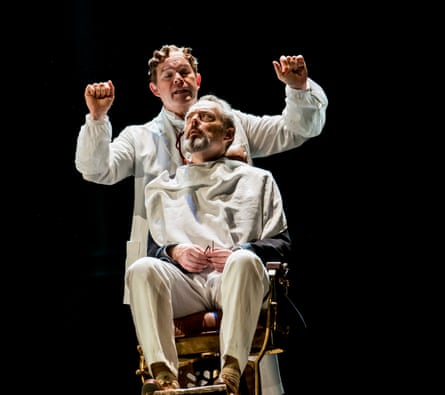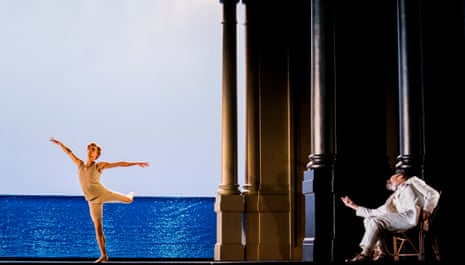Now bathed in sunlight, now plunged into morbid shadow, the Royal Opera House’s new production of Death in Venice (1973), its first in more than a quarter of a century, is hard to fault. At a glance, it exposes the opposing forces tugging at Britten’s last opera: youth and age, health and sickness, head and heart. David McVicar’s traditional staging, designed with loving detail and bold concept by Vicki Mortimer (lighting by Paule Constable), recreates a mood of pre-first world war elegance. We, too, are guests in the columned foyer of the Hôtel des Bains on the Lido, looking out to sea and eternity. This was where Thomas Mann stayed in 1911 and found inspiration for Der Tod in Venedig, the novella on which Britten based his opera.
The tale is familiar, partly thanks to Visconti’s 1971 movie starring Dirk Bogarde (its filming coincided with Britten writing his opera: to avoid accusations of plagiarism he was advised not to see it). A widowed writer, Gustav von Aschenbach, goes to Venice longing for creative rejuvenation. Instead, his thoughts are consumed by a beautiful Polish boy, Tadzio. They never speak. The sirocco blows. The threat of cholera deepens. Much of the action is provided by one baritone – here, the ingenious and versatile Gerald Finley – who plays the multiple roles of traveller, player, fop, barber, voice of Dionysus. Some of these characters are real, some inhabit Aschenbach’s frenzied mind.
This uneasy work, not helped by Myfanwy Piper’s dense libretto, is rendered unmissable by its glittering, restless score, rich with gongs and bells, piano and harp, superbly played by the Royal Opera House orchestra, conducted with clarity and perception by Richard Farnes. Is its chief theme an older man’s love for untainted youth, or is it a meditation on the vulnerabilities of the creative life? Given Britten’s frail health at the time, and his acknowledged boy crushes, it’s easy to assume the former. He wrote the towering role of Aschenbach for his partner, the tenor Peter Pears, here sung with minute nuance and unflagging eloquence by Mark Padmore.

Death in Venice may well have represented the unleashing of a lifetime’s repressed feelings, yet Britten’s vision was wider, more ambitious: it’s about the essence of art itself. McVicar has honoured this with a production overflowing with pathos and sympathy. Emotion burns more fiercely than sexuality. Lynne Page’s muscular choreography, too, emphasises physicality above eroticism, with Royal Ballet dancer Leo Dixon athletic and knowing in the non-speaking role of Tadzio. The ROH chorus, and an ensemble cast including Tim Mead (Apollo), Dominic Sedgwick, Rebecca Evans, Sam Furness and Michael Mofidian, grasp their brief moments with style.
Music from the opera surfaces in Britten’s Third String Quartet (1975), written in the last months of his life, partly in Venice. Hearing the work played at Wigmore Hall by the Doric String Quartet – experts in this repertoire – the day after seeing Death in Venice was like listening to a distillation of the opera, full of that same wistful poetry and despair: the composer’s farewell to life, still in creative mid-stream.
In a Radio 3 lunchtime concert, also at Wigmore Hall (and broadcast again today, 1pm), the eight-strong Marian Consort brought this week of late Britten full circle with a radiant performance of one of his earliest works, A Hymn to the Virgin (1930, rev 1934). Written when he was a schoolboy, the anthem was one of only two works to be sung at his funeral in 1976. In their programme, entitled Music for the Queen of Heaven, the consort mixed Tudor music with new works, shining especially in music by Roxanna Panufnik, Cecilia McDowall and Judith Weir: a welcome gleam of ethereal cheer in dark days.

Comments (…)
Sign in or create your Guardian account to join the discussion